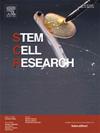CNGA1基因突变视网膜色素变性患者iPSC细胞系(BTHBIOi001-A)的生成
IF 0.7
4区 医学
Q4 BIOTECHNOLOGY & APPLIED MICROBIOLOGY
引用次数: 0
摘要
色素性视网膜炎(RP)是一组由基因突变引起的遗传性视网膜疾病,导致进行性光感受器变性和最终失明。CNGA1基因突变可引起常染色体隐性视网膜色素变性(ARRP)。在这里,我们产生了一个视网膜色素变性患者的人类iPSC系,其基因突变为CNGA1基因(纯合子c.1621G >;一个;p.R 420 >;Q),通过使用包括OCT4, SOX2, c-Myc和KLF4的非积分集向量系统。经鉴定,该细胞系具有正常的女性核型(46,XX),表达多能性标记,并具有在体外分化为三种胚层的能力。本文章由计算机程序翻译,如有差异,请以英文原文为准。
Generation of a human iPSC line (BTHBIOi001-A) from a retinitis pigmentosa patient with CNGA1 gene mutation
Retinitis pigmentosa (RP) is a group of inherited retinal disorders caused by genetic mutations, leading to progressive photoreceptors degeneration and eventual blindness. Mutations in CNGA1 can cause autosomal recessive retinitis pigmentosa (ARRP). Here, a human iPSC line of a retinitis pigmentosa patient was generated, with the mutation of CNGA1 gene (homozygous c.1621G > A; p.R 420 > Q), by using a non-integrating episomal vector system including OCT4, SOX2, c-Myc and KLF4. It is identified that the cell line showed a normal female karyotype (46, XX), expressed pluripotency markers, and had the ability to differentiate into three germ layers in vitro.
求助全文
通过发布文献求助,成功后即可免费获取论文全文。
去求助
来源期刊

Stem cell research
生物-生物工程与应用微生物
CiteScore
2.20
自引率
8.30%
发文量
338
审稿时长
55 days
期刊介绍:
Stem Cell Research is dedicated to publishing high-quality manuscripts focusing on the biology and applications of stem cell research. Submissions to Stem Cell Research, may cover all aspects of stem cells, including embryonic stem cells, tissue-specific stem cells, cancer stem cells, developmental studies, stem cell genomes, and translational research. Stem Cell Research publishes 6 issues a year.
 求助内容:
求助内容: 应助结果提醒方式:
应助结果提醒方式:


